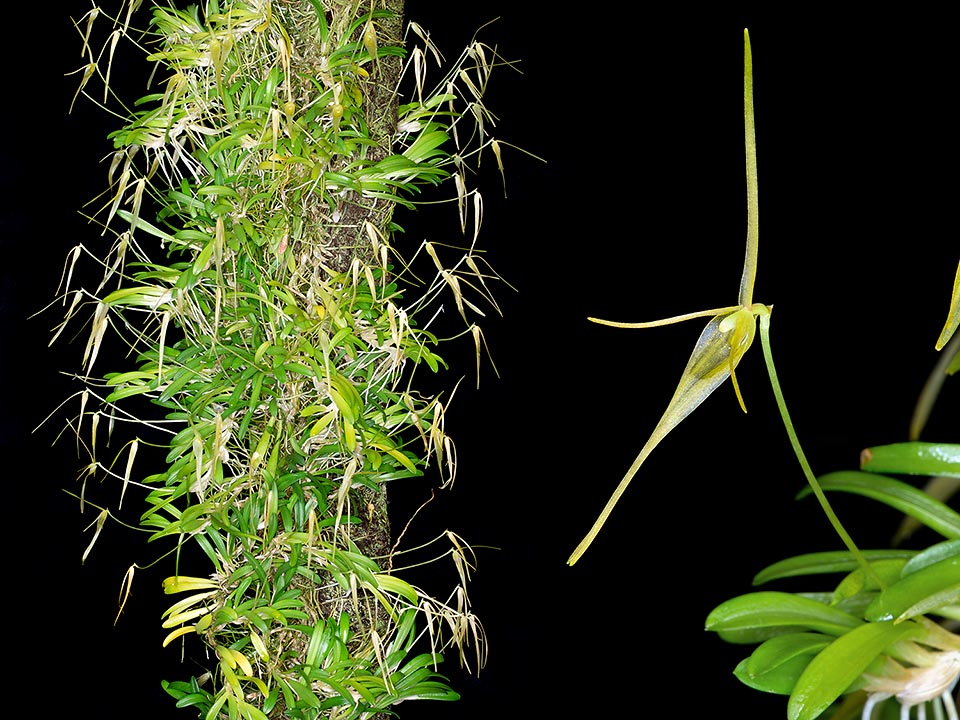Family : Orchidaceae

Text © Pietro Puccio

English translation by Mario Beltramini
The species is native to Bolivia, Colombia, Ecuador, Peru and Venezuela where it grows on the trees of the Andean humid forests or on rocks covered by moss, between the 1500 and 3200 m of altitude.
The genus is honoured to the Brazilian explorer and naturalist João Barbosa-Rodrigues (1842-1909); the specific name is the Latin adjective “cucullatus, a, um” = hooded, cucullated, with reference to the shape of the column that recalls the “cucullus”, typical Gaulish headgear.
The Barbosella cucullata (Lindl.) Schltr. (1918) is an epiphytic or lithophytic species, rather variable, with short creeping rhizome that forms dense tufts with short stems provided at the apex of one single oblong-linear to oblanceolate leaf, 4-10 cm long and 0,4-0,8 cm broad, coriaceous, of pale green colour and glossy above. Inflorescence, on thin erect peduncle, 8-18 cm long, bearing one single diaphanous flower of variable colour, yellow to pale brown to purple, with linear dorsal sepal with long pointed apex, 2-5 cm long and 0,2 cm broad, lanceolate-linear lateral sepals long pointed and merged to form a unique bifid sepal at the apex, almost of the same length as the dorsal and 0,4-0,6 m broad at the base, filiform petals, 1-2 cm long and 0,1-0,2 cm broad at the base, oblong fleshy labellum, 0,3 cm long and 0,2 cm broad, and cucullated column, 0,3 cm long and 0,1 cm broad. It reproduces by seed, in vitro, and by division with each section provided of at least 3-4 pseudobulbs. Small sized species with generous blooming, requires a shady position, rather cool temperatures, 10-25 °C, medium-high humidity, 65-75%, and constant ventilation.

Barbosella cucullata is an epiphytic or lithophytic species native to Bolivia, Colombia, Peru and Venezuela. It forms dense tufts with pale green leaves, glossy above and coriaceous, of 4-10 cm. Single diaphanous flowers of variable colour, yellow to pale brown to purple carried by a thin 8-18 cm peduncle, with dorsal linear sepal long pointed, of 2-5 cm and analogous lateral sepals. Filiform 1-2 cm petals with fleshy oblong labellum, 0,3 cm long and 0,2 cm broad, and cucullated column, 0,3 cm long and 0,1 cm broad, that, as the specific name states, reminds a typical Gaulish headgear. Relatively easy cultivation and very generous blooming © Giuseppe Mazza
The waterings must be frequent and abundant in summer, more spaced in winter allowing the substratum to dry up partially before giving water again, but without ever letting it to dry up completely, utilizing rain water, demineralized or by reverse osmosis. Fertilizations every fortnight utilizing preferably a balanced hydrosoluble product, with microelements, at 1/8 of the dosage shown on the package, being the roots sensitive to salts accumulation. It can be mounted on trunks, bark or rafts of cork or of roots of arborescent ferns, on a layer of sphagnum to maintain the humidity, or in pots or baskets with compost formed by medium sliced bark fragments and sphagnum. Transplants and repottings are to be done only when strictly necessary at the vegetative restart. Due to the reduced dimensions it adapts to be cultivated in terraria and orchidaria for internal ambients.
The species is reported in the appendix II of CITES (species whose trade is internationally ruled).
Synonyms: Restrepia cucullata Lindl. (1845); Restrepia rhynchantha Rchb.f. & Warsz. (1854); Restrepia varicosa Lindl. (1859); Restrepia antennifera var. angustifolia Kraenzl. (1899); Masdevallia longiflora Kraenzl. (1906); Barbosella rhynchantha (Rchb.f. & Warsz.) Schltr. (1918); Barbosella longipes Schltr. (1920); Barbosella longiflora (Kraenzl.) Schltr. (1921); Pleurothallis rhynchantha (Rchb.f. & Warsz.) L.O.Williams (1939); Pleurothallis angustisegmenta C.Schweinf. (1942).
→ For general notions about ORCHIDACEAE please click here.
